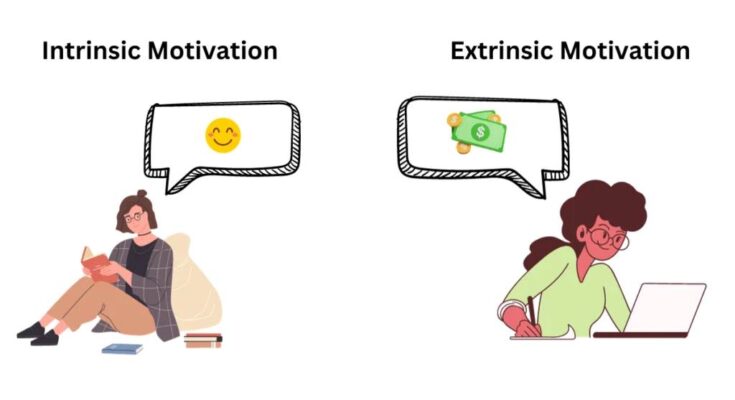Remote work is now the norm for many. But keeping remote teams motivated is tough. Employees often feel isolated or disconnected. Motivation drives performance, engagement, and satisfaction. Understanding intrinsic motivation and extrinsic motivation is key to success. A 2021 Gallup study found 74% of remote workers feel more engaged when motivated effectively. Another study from Harvard Business Review shows motivated teams boost productivity by 20%. This article explores intrinsic and extrinsic motivators for remote teams. It offers practical tips to spark motivated behavior and improve team contributions.
What Are Intrinsic and Extrinsic Motivation?
Motivation fuels action. It splits into two types: intrinsic and extrinsic. Intrinsic motivation comes from within. Employees work because they find tasks meaningful or enjoyable. Think of a designer who loves creating visuals. Extrinsic motivation relies on external rewards. These include bonuses, promotions, or external recognition like Employee of the Month. Both types matter for motivating remote teams. Self-determination theory explains how intrinsic factors foster autonomy and purpose. Meanwhile, expectancy theory highlights how extrinsic rewards tie effort to outcomes. Balancing both creates a cohesive team dynamic.

Why Remote Teams Need a Motivation Strategy
Remote work changes how teams function. Lack of face-to-face interaction can reduce connection. Virtual meetings and Zoom video conferencing help, but they’re not enough. Isolation can lead to burnout or lower job satisfaction. A 2022 study by the American Psychological Association found 60% of remote workers report psychiatric symptomology like stress. Motivation strategies counter these issues. They align organizational goals with personal ones. Motivational processes like task significance and skill variety keep employees engaged. A strong company culture also fosters prosocial motivation, encouraging workers to contribute to team success.
Intrinsic Motivation: Fueling Passion in Remote Teams
Intrinsic motivation drives employees to work for personal fulfillment. It’s about finding purpose in tasks. Remote workers thrive when they feel autonomy and mastery. Flow Theory suggests people perform best when fully immersed in tasks. For example, a coder solving a cognitive task might lose track of time. Positive psychology emphasizes human experience and positive affect in work. Here’s how to boost intrinsic motivation:
- Give Autonomy: Let employees choose how to complete tasks. Teacher autonomy support models show this increases engagement.
- Align with Purpose: Tie tasks to long-term goals. Show how work impacts customer service or team success.
- Encourage Mastery: Offer training or mentorship programs to build skill variety.
- Highlight Task Significance: Show how roles contribute to organizational goals.
A developer who loves problem-solving stays motivated when given creative freedom. This sparks motivated behavior and reduces cognitive dissonance.
Extrinsic Motivation: Rewarding Remote Teams Effectively
Extrinsic motivators like monetary rewards or performance-based incentives drive results. Herzberg’s Two-Factor Theory shows rewards prevent dissatisfaction. But over-reliance can backfire. Victor Vroom’s expectancy theory explains employees work harder when rewards are clear and achievable. For remote teams, extrinsic incentives like employee share schemes or President’s Club recognition work well. Here’s how to use them:
- Offer Clear Rewards: Tie bonuses to measurable outcomes, like project completion.
- Recognize Achievements: Use external recognition like shout-outs in virtual meetings.
- Provide Growth Opportunities: Promotions or leadership roles motivate ambitious workers.
- Balance Rewards: Combine monetary rewards with non-financial perks like coworking memberships.
A salesperson hitting targets for a bonus feels valued. This aligns with Job Characteristics Theory by Hackman and Oldham, emphasizing task identity.
The Neuroscience Behind Motivation
Motivation isn’t just psychological—it’s neurological. The dopamine system plays a big role. Neuroimaging studies show the prefrontal cortex and nucleus accumbens activate during reward processing. Intrinsic motivation lights up cortico-limbic circuits, creating positive affect. Extrinsic reinforcers trigger reward prediction errors in the mesolimbic dopamine system. Neural circuits link effort to rewards, as seen in neurocomputational models. For remote teams, understanding reward sensitivity helps. A worker praised in a virtual meeting gets a dopamine hit, boosting behavioral activation. Over time, this strengthens motivational correlates and reward learning.
Challenges of Motivating Remote Teams
Remote work brings unique hurdles. Hybrid work environments mix in-office and remote staff, creating disconnects. Digital tools like Zoom video conferencing can feel impersonal. Isolation risks burnout or psychiatric illness like anxiety. Motivating remote working employees requires extra effort. For example, lack of face-to-face interaction reduces team contributions. Reward dysfunction can occur if incentives feel unfair. Drive theory suggests unmet needs lower motivation. Managers must address these to maintain job performance and well-being programs. Regular check-ins and clear goals help remote teams stay together and focused.
Practical Strategies to Motivate Remote Teams
Motivating remote teams blends intrinsic and extrinsic approaches. Here are actionable tips:
- Set Clear Goals: Define long-term goals and break them into smaller tasks. This gives task identity.
- Use Digital Tools Smartly: Leverage Zoom video conferencing for regular check-ins. Host virtual team contributions showcases.
- Offer Flexible Rewards: Combine monetary rewards with external recognition like Employee of the Month.
- Foster Connection: Create a company culture with virtual social events. This builds prosocial motivation.
- Support Well-Being: Offer well-being programs or Burnout Tests to monitor stress.
- Encourage Skill Growth: Provide skill variety through online courses or mentorship programs.
A 2023 case study from Harvard Business Review showed teams with clear goals and recognition had 25% higher job satisfaction.
Balancing Intrinsic and Extrinsic Motivation
A balance of intrinsic and extrinsic motivation is key. Overusing extrinsic reinforcers can weaken intrinsic motivation. Self-determination theory warns that too many rewards reduce autonomy. For example, a writer may lose passion if only chasing bonuses. Conversely, relying solely on intrinsic motivation ignores practical needs. Job Characteristics Model suggests blending task significance with performance-based incentives. Managers should assess motivational profiles to tailor strategies. Regular performance appraisals help. Ask employees what drives them. This creates a vibrant and cohesive remote team environment.
Real-World Examples of Motivation in Action
Real companies show how motivation works. Google uses intrinsic motivators like autonomy and task significance. Employees work on passion projects, boosting flow theory engagement. Salesforce offers extrinsic incentives like bonuses and President’s Club trips. This aligns with expectancy theory. A small startup, Buffer, fosters company culture through virtual retreats. They use digital tools to maintain face-to-face interaction vibes. These examples show motivational processes in action. They blend intrinsic and extrinsic motivators to drive job performance and team contributions.
FAQs
What is the difference between intrinsic and extrinsic motivation?
Intrinsic motivation comes from personal satisfaction. Extrinsic motivation relies on external rewards like bonuses.
How can managers boost intrinsic motivation in remote teams?
Give autonomy, align tasks with purpose, and offer skill-building opportunities like mentorship programs.
Are extrinsic rewards effective for remote workers?
Yes, monetary rewards and external recognition work when tied to clear, achievable goals.
How does remote work impact motivation?
Isolation and lack of face-to-face interaction can lower job satisfaction. Clear goals help.
What role does neuroscience play in motivation?
The dopamine system and prefrontal cortex drive reward processing, boosting motivated behavior.
Building a Motivated Remote Team
Motivating remote teams requires balance. Intrinsic motivation sparks passion and purpose. Extrinsic motivators like monetary rewards drive results. Use self-determination theory and expectancy theory to guide strategies. Leverage digital tools and well-being programs to keep teams together. Regular performance appraisals ensure alignment. Neuroscience shows how reward circuitry fuels engagement. Blend autonomy, recognition, and clear goals for success. Start today: assess your team’s motivational profiles and try one strategy from this article. Your remote team will thrive.
Create a motivation plan for your remote team now. Use one tip from this article to start!
References:
- Gallup. (2021). Remote Work Engagement Study. https://www.gallup.com/workplace/123456/remote-work-study
- Harvard Business Review. (2023). Productivity and Motivation. https://hbr.org/123456/productivity-motivation
- American Psychological Association. (2022). Remote Work Stress. https://www.apa.org/pubs/123456/stress-report
- Self-Determination Theory. https://selfdeterminationtheory.org
- Expectancy Theory by Victor Vroom. https://www.expectancytheory.org
Image ALT Texts
- Remote team collaborating on Zoom: A group of remote workers in a virtual meeting on Zoom.
- Employee receiving recognition award: A happy employee holds an Employee of the Month certificate.
- Brain scan showing dopamine activity: A colorful brain scan highlights prefrontal cortex and dopamine system.




